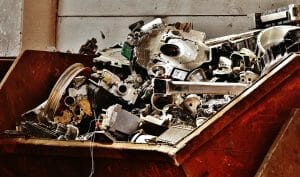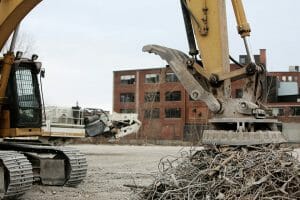Scrap metal is virtually everywhere. From automobiles, to buildings and electronics, ferrous and non-ferrous metals are abundant and widely used. With such large amounts of scrap metals readily available, gathering items for scrap metal recycling can help free up space and put some extra cash in your pocket. But, before you go running around and picking up every hunk of metal you see, it is important to know which scrap metals are accepted and the differences between them.

Scrap yards and scrap metal recycling centers accept two types of scrap metals. The first are ferrous metals. The second are non-ferrous metals. The former deals with metals containing iron and steel. Ferrous metals are magnetic and usually less resistant to corrosion than non-ferrous metals. Old automobiles, farm equipment, household appliances, steel beams, railroad tracks, ships, and food packaging are examples of ferrous metals. This type of scrap metal accounts for the largest volume of metal scrapped nationally. If you are unsure of which type of scrap metal you are in possession of, magnetism is one of the fastest ways to learn the answer. In this case, magnets are not the same as the one stuck to the side of your refrigerator. Determining ferrous properties requires the use of powerful scrap metal magnets that can usually be found at hardware stores or online.
Aluminum and copper are both examples of non-ferrous metals since they are not magnetic. Generally, copper has the highest payout of all non-ferrous metals at most scrapyards. So, before you go and throw out that old electrical appliance or stereo, stripping the copper wiring can be worthwhile. Brass, which is commonly found in pipe fittings and plumbing fixtures, is the second most valuable scrap metal. Millions of tons of nonferrous scrap metal are recovered by processors and consumed by secondary smelters, refiners, ingot makers, fabricators, foundries, and other industries in this country.
Reusing Scrap Metal

The scrap metal industry was valued at 36 billion dollars in 2017. It produces this revenue through the recycling of home scrap and purchased scrap. Home scrap is scrap metal generated at the mill, refinery, or foundry, and is generally re-melted and used again at the same plant. Home scrap is called home scrap because it never leaves the plant. On the other hand, purchased scrap is scrap metal that is not used in the finished product or obsolete due to lack of functionality. Obsolete scrap metals are items like appliances, electronics and pipes that no longer work. The automotive industry is the biggest producer of purchased scrap simply because of the leftover scrap metals their products create. Most scrap yards and mill facilities specialize in recycling purchased scrap.
Annually, the scrap metal industry recycles 56 million tons of scrap iron and steel, 1.5 million tons of scrap copper, 1.3 million tons of scrap lead and 800,000 tons of stainless steel scrap. This lucrative industry operates on principles Man has been relying on since the Bronze Age. Melting down scrap metals and reusing them allows for greater market availability. Natural resources are conserved, and, in turn, big businesses have access to the growth materials they require. Recycled scrap metals are utilized in a variety of projects including skyscrapers, aerospace equipment, household appliances, piping, electronics, computers, ships, railroads, automobiles, industrial machinery and also electrical wiring.
Recycling Scrap Metal at Our Scrap Yards

So, what happens when you bring a shipment of scrap metal to a scrap yard? Well, the scrap facility usually starts by stripping the scrap metal down to its most basic components. Recyclers can recover copper and lead from radiators, platinum from automobile catalytic converters, gold from computer electrical boards, and silver from spent photographic film. The scrap metal processors then collect, sort, process, and eventually sell the scrap metal to foundries, mills, mini-mills, and other purchasers. In order to properly handle and recycle that scrap metals, most processors rely on a myriad of equipment.
Most scrap yards will have a crane that is either a traditional cable type or a hydraulic crane that is available on crawler, truck, pedestal, gantry, rail, or overhead mountings. Large magnets or grapples are attached to the cranes that lift and move the ferrous scrap. Processors may have a hydraulic baling press, an alligator shear, or hydraulic guillotine shear. Some scrap facilities even have shredders that reduce large chunks of scrap metal into much smaller pieces of scrap. The ability of scrap yards to effectively strip and reuse vital components of their scrap metal continues to supply the world with vital elements that are essential to the prosperity of civilization.